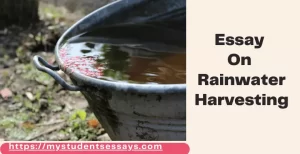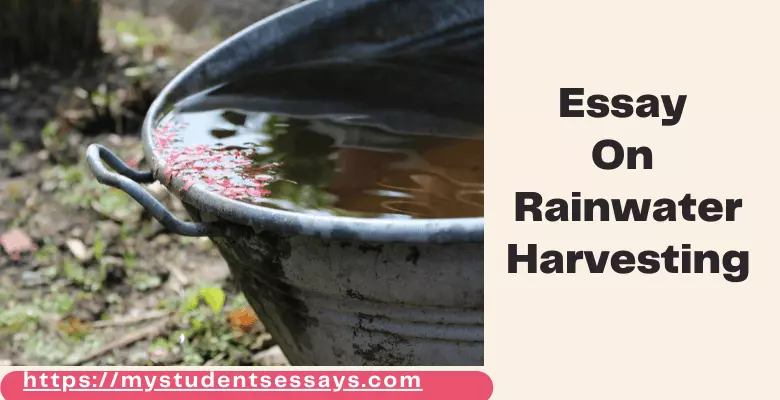Rainwater harvesting is the collection, storage and use of rain water for irrigation, potable (drinking), non-potable uses such as toilet flushing where it can be treated to remove impurities before use.
Essay on Rainwater Harvesting | Methods, Benefits of Rainwater Harvesting
Rainwater harvesting is the simplest and most cost-effective method of providing an individual or a community with clean, potable water. It has been used for centuries in many parts of the world to provide a reliable source of water, especially during the dry season. In addition, rainwater is extremely pure as it contains no sediments or other pollutants, and requires minimal treatment. It can be an especially valuable resource in places where ground water is either nonexistent or of poor quality.

Rainwater Harvesting in India
Rainwater harvesting in a systematic manner has been an age old tradition in India which was mostly used to meet the needs of basic drinking water for people living in remote villages. The system was easy and effective, though at times laborious. This water is first collected from Gumbads (big pots) which are placed on the rooftop areas of houses or public places like temples etc.
The water would be diverted by means of a channel through a pipe in the house to a storage tank kept in an elevated position. The Gumbads with inlet pipes are also placed at places where water flow is high like temple steps etc., thus ensuring sufficient supply of drinking water for devotees. However, with the onset of time these traditional systems have been replaced by more sophisticated ones employing various modern tools and gadgets.
>>> Related Essay: Essay on Drought for Students
In recent times Rainwater harvesting is being used to meet the water needs of urban residents, especially in cities where there is a chronic shortage of fresh drinking water. The city of Bangalore has been using this technique since 1980s for residential and commercial establishments. In fact, it was during summer time in 1985 that about four lakh litre rainwater was harvested from 1000 buildings in Bangalore. Since then many apartment complexes as well as individual houses have been using this system to meet their water needs.
Methods of Rainwater Harvesting
The harvesting is done from rooftops, terraces and other flat areas by using small to large capacity systems having an appropriate storage tank or a reservoir for rainwater close to the building. This provides an additional source of water which can be used for various purposes like watering the garden, flushing the toilet and also outdoor washing. These systems are designed and installed to ensure that rainwater is harvested as per spatial area as well as volume required by a particular structure.
Importance of Rainwater Harvesting
Rainwater harvesting is the most reliable of all water supply methods. The rainwater can be used for many purposes, including drinking water, watering plants, flushing toilets and washing clothes. A house with a traditional roof merely has to have its runoff directed to an open channel or swale leading to a storage facility providing water for landscape irrigation or other uses.
Benefits of Rainwater Harvesting
Rainwater harvesting, when taken to an even higher level, is known as full water cycle management. This means that collected rainwater can be stored for later use over weeks or months, instead of being immediately consumed where it falls. By doing this you eliminate any need for expensive long pipelines bringing in water from far away, which is both costly and damaging to the environment. The entire neighborhood can collect water for its own use at a fraction of the cost of buying it in bulk or via tanker delivery, thus creating job opportunities and creating an income source for communities.
Rainwater harvesting systems are used to supply drinking water for humans, animals and irrigation. Harvested rainwater is often filtered for use as drinking water; if contamination is found, the water can be stored for later, or blended with other sources of potable water to dilute the contaminant.
Rainwater harvesting systems are very important in drought-prone areas because they provide clean water without depending on an expensive and environmentally damaging long pipeline system from a distant source. This allows rainwater to be used for drinking, bathing, cooking etc.
In rural areas this water is commonly provided by hand pumps or local borehole wells which draw groundwater from aquifers. In urban areas the collected water may be used in conjunction with natural gas or electricity to run pumps, providing domestic water for house use.
The water collected by the rainwater harvesting system can be used to irrigate crops or any other uses, for example flushing toilets. When this is done it avoids the need to connect to a sewer system, which means an entire network of sewage pipes doesn’t have to be constructed and maintained. This saves money for the community, but also reduces the environmental damage since sewage doesn’t have to be piped long distances where around 90% of its energy is lost.
When used in combination with a system that provides clean water to toilets and washes clothes and dishes, it can be very effective at promoting hygiene and good health. This is an important benefit of rainwater harvesting, especially in developing countries where the provision of clean water to all members of a family or community is not always available.
The use of rainwater harvesting provides employment opportunities for people who install and maintain the systems. Often these systems require maintenance and new installations on a regular basis and employing local workers and training them to provide this service is important.
By using rainwater harvesting systems, communities can save money and protect the environment. This is particularly helpful in agriculture where it reduces the cost of irrigation while also leveling out any variations in rainfall from year to year so that farmers don’t have to worry about crops failing due to drought or flooding.
The environmental advantages of rainwater harvesting are very important in that it reduces the impact on ecosystems where the water is used. Many communities see runoff into lakes and rivers as a wasted source, when in fact it causes damages to aquatic systems since contaminants are washed directly into them without being filtered by natural sinks along the way.
Rainwater Harvesting has many advantages, among them are reduction of heat build up in cities., water conservation for drought-stricken areas, infiltration into the ground keeping it high and dry during floods, recharge groundwater aquifers at times of low rainfall.
Rainwater harvesting is used to provide an alternative source of water when other fresh sources like well or ground water are not available. In urban cities, to maintain a supply of fresh drinking water, it is practiced for using roof top rainwater harvesting systems from the rooftop areas of apartment complexes and complexes with big blocks to reduce the usage of ground water.
>>> Related Post: Essay on Gardening and its importance
Conclusion
Rainwater harvesting is now becoming necessary because of the growing pollution. People now are aware of the importance of this system and a lot of people have started to save water from any source for their future use. Rainwater harvesting provides a sustainable solution to increase groundwater recharge potentials. This helps us to protect our environment from further damage due to deforestation, through recharging the ground water, and also reduces the cost of importing water from other regions.
